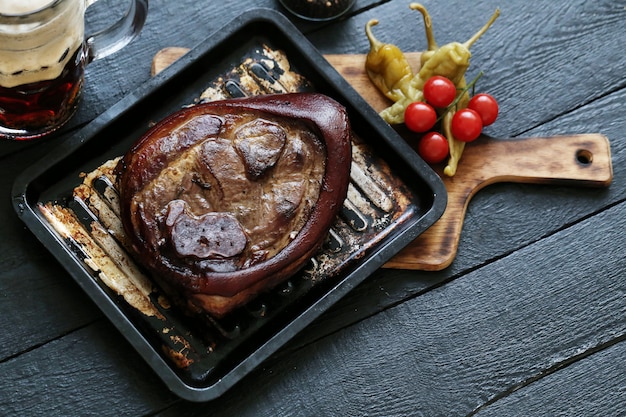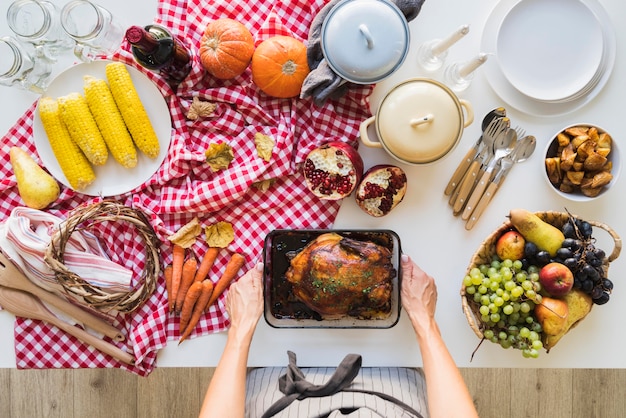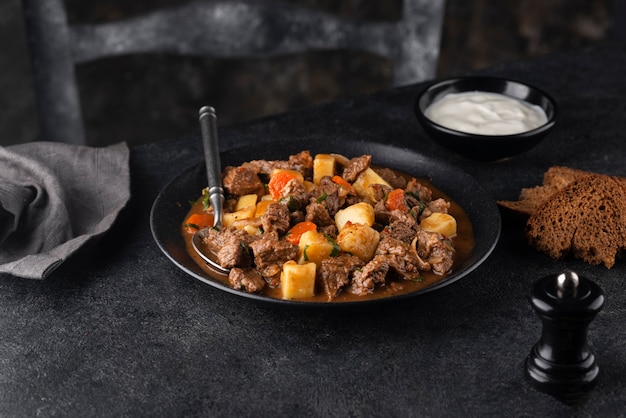Ah, pot roast. The mere mention of those two words conjures up images of warm, comforting meals, family gatherings, and the tantalising aroma of slow-cooked beef filling your home. It's a dish that's been passed down through generations, a culinary staple that never fails to deliver. But let's be honest, achieving that perfect pot roast, where the meat is meltingly tender and bursting with flavour, isn't always a sure thing. That's where the magic of temperature comes in.
Over the years, I've learned that cooking the perfect pot roast is like a well-rehearsed symphony. It's about understanding the subtle nuances of heat, time, and technique, and how they all play together to create a harmonious outcome. And believe me, when it comes to pot roast, the temperature is the conductor, leading the melody of flavour and texture.
This guide will serve as your personal conductor, leading you through the intricate symphony of pot roast perfection. From understanding the science behind the perfect temperature to mastering the art of slow cooking, you'll gain the knowledge and confidence to create mouthwatering results every time. So, grab your apron, put on your favourite tunes, and let's embark on this culinary adventure together!
(Part 1) Unlocking the Secrets: The Science Behind Temperature and Tenderness

Before we dive into the specifics of temperature, let's delve a bit deeper into the science behind it. You see, cooking a pot roast isn't just about applying heat; it's about understanding how heat transforms the very structure of the meat. It's about orchestrating a chemical transformation, where the tough fibers soften and the natural juices release their rich, savory flavours.
The Unsung Hero: Collagen
Collagen, the tough, fibrous protein found in connective tissues, is the real hero of our story. It's what gives meat its structure and, unfortunately, its toughness. But when you cook meat at a low temperature, something magical happens. The collagen molecules slowly break down and transform into gelatin, a substance that's silky smooth and adds that incredible tenderness we crave.
internal temperature: The Key to Success
While time plays a crucial role, it's the internal temperature of the meat that truly dictates its level of tenderness. This is where the trusty meat thermometer comes in. It's the maestro of the orchestra, providing real-time feedback on the heat's progress within the meat. The thermometer allows you to monitor the internal temperature with precision, ensuring the meat reaches the perfect point for juicy, tender perfection, while also guaranteeing food safety.
(Part 2) choosing the right cut: A Symphony of Flavour and Texture

The first step in our pot roast symphony is selecting the right instrument, or in this case, the right cut of meat. Not all cuts are created equal, and some are inherently better suited for the slow, gentle heat of pot roast cooking than others.
The Best Cuts for Pot Roast: A Selection of Stars
Here are some of the most celebrated cuts of beef for pot roast, known for their rich flavours and ability to transform into melt-in-your-mouth tenderness with slow cooking:
- chuck roast: A classic choice for a reason, chuck roast is a symphony of marbling, adding a richness of flavour and juiciness that's hard to resist.
- Brisket: This is a tough cut that truly benefits from slow cooking. Brisket is known for its deep, complex flavour that becomes truly magical when cooked low and slow.
- Round Roast: Leaner than chuck or brisket, round roast can be a bit tougher, but it becomes wonderfully tender when given ample time to cook.
- Shoulder Roast: A close relative of chuck roast, shoulder roast boasts similar marbling and is a great choice for pot roast.
(Part 3) The Art of Seasoning: Adding Harmony to Your Dish

While temperature is the conductor, seasoning is the composer, adding layers of complexity and depth to our pot roast symphony. The right blend of spices can transform a simple dish into a culinary masterpiece, bringing out the best in each note of flavour.
Essential Seasoning for Pot Roast: The Building Blocks of Flavour
Here are some essential spices that are sure to add a harmonious touch to your pot roast:
- Salt and Pepper: The foundation of any good seasoning, salt and pepper enhance the natural flavour of the meat, bringing out its inherent melody.
- Onion Powder and Garlic Powder: These add a depth of flavour and aroma, creating a rich, savory base for your pot roast.
- Paprika: A touch of paprika adds a subtle sweetness and warmth, providing a delicate counterpoint to the savoury notes of the meat.
- Dried Herbs: Rosemary, thyme, and oregano are classic herbs that pair beautifully with pot roast, adding a fragrant, herbaceous complexity.
(Part 4) The Perfect Pot Roast Temperature: A Detailed Orchestration
Now, let's get to the heart of our symphony: the perfect pot roast temperature. Remember, internal temperature is the conductor, dictating the tempo and rhythm of tenderness and flavour.
Safety First: The Minimum Internal Temperature for Beef
The USDA recommends cooking beef to an internal temperature of at least 145°F (63°C) for medium-rare. However, for pot roast, we aim for a higher temperature, allowing the collagen to fully break down and the meat to achieve that coveted melt-in-your-mouth tenderness.
The Ideal Temperature for Pot Roast: Striking the Perfect Note
The ideal internal temperature for a pot roast is between 190°F (88°C) and 205°F (96°C). At this temperature, the collagen has completely transformed into gelatin, resulting in a pot roast that's both tender and juicy. This is where the real magic happens, where the symphony of flavour and texture reaches its crescendo.
(Part 5) Cooking Methods: Oven or slow cooker? Two Ways to Achieve Pot Roast Perfection
We've explored the science and the ingredients, but now we need to choose our instrument: the oven or the slow cooker. Both methods offer their unique advantages, leading to a delicious pot roast finale.
Oven Cooking: Precision and Control for a Refined Pot Roast
Oven cooking allows for more precise temperature control, allowing you to carefully adjust the heat to achieve the perfect tempo. Additionally, browning the pot roast before slow cooking in the oven adds a beautiful crust and a layer of depth to the flavour. It's a method that's both elegant and effective.
Slow Cooker: A Hands-Off Approach for a Relaxed Meal
Slow cookers are ideal for busy weeknights, offering a hands-off approach to pot roast cooking. You can simply throw all the ingredients into the slow cooker, set it on low, and let it work its magic. Slow cookers are also perfect for large gatherings, as they can easily handle a large pot roast, ensuring that everyone gets a generous helping.
(Part 6) The Oven-Baked Pot Roast: A Step-by-Step Guide to Mastering the Orchestra
Let's start with the oven-baked pot roast. This method allows for precise temperature control and a beautiful browning, resulting in a pot roast that's visually appealing and bursting with flavour.
Ingredients You'll Need: The Symphony of Flavour Begins
- 3-4 pound chuck roast
- 1 tablespoon olive oil
- 1 teaspoon salt
- 1/2 teaspoon black pepper
- 1 teaspoon onion powder
- 1/2 teaspoon garlic powder
- 1/2 teaspoon paprika
- 1/2 cup beef broth
- 1/2 cup chopped onion
- 2 carrots, peeled and chopped
- 2 celery stalks, chopped
Step-by-Step Instructions: A Culinary Symphony
- Preheat your oven to 325°F (163°C). This sets the stage for our culinary performance, warming the oven to the perfect temperature for slow cooking.
- Season the roast: Rub the chuck roast with olive oil, salt, pepper, onion powder, garlic powder, and paprika. This is where we add the first layer of flavour, creating a harmonious blend of spices that will permeate the meat.
- Brown the roast: Heat a large dutch oven or oven-safe skillet over medium-high heat. Sear the roast on all sides, about 5 minutes per side, until browned. This step is crucial, as it adds a beautiful crust and enhances the depth of flavour. It's like adding a rich, complex melody to our symphony.
- Add vegetables and broth: Remove the roast from the Dutch oven and set aside. Add the chopped onion, carrots, and celery to the pot and cook until softened, about 5 minutes. Pour in the beef broth. This is where we introduce the supporting cast of vegetables and broth, creating a symphony of textures and flavours.
- Return the roast to the pot: Place the browned roast back into the Dutch oven. Cover tightly with a lid. This is the moment we bring all the elements together, creating a harmonious blend of flavours and textures.
- Bake: Bake for 3-4 hours, or until the internal temperature reaches 190°F (88°C). Check the temperature using a meat thermometer inserted into the thickest part of the roast. This is where the slow, gentle heat of the oven works its magic, transforming the tough fibers into tender, succulent goodness.
- Rest: Remove the roast from the oven and let it rest for 15 minutes before slicing and serving. This allows the juices to redistribute throughout the meat, ensuring a moist and flavorful final product.
(Part 7) The slow cooker pot roast: A Relaxed and Effortless Approach
For those seeking a more relaxed and effortless approach, the slow cooker pot roast is a perfect choice. This method is ideal for busy weeknights, offering a "set it and forget it" convenience that allows you to spend less time in the kitchen and more time enjoying the company of loved ones.
Ingredients You'll Need: A Simplified Symphony
- 3-4 pound chuck roast
- 1 tablespoon olive oil
- 1 teaspoon salt
- 1/2 teaspoon black pepper
- 1 teaspoon onion powder
- 1/2 teaspoon garlic powder
- 1/2 teaspoon paprika
- 1/2 cup beef broth
- 1/2 cup chopped onion
- 2 carrots, peeled and chopped
- 2 celery stalks, chopped
Step-by-Step Instructions: Effortless Pot Roast Harmony
- Season the roast: Rub the chuck roast with olive oil, salt, pepper, onion powder, garlic powder, and paprika. This adds the initial layer of flavour, setting the stage for a delicious pot roast symphony.
- Place in the slow cooker: Place the seasoned roast in the slow cooker. This is where we begin the slow, gentle transformation of the meat.
- Add vegetables and broth: Add the chopped onion, carrots, and celery to the slow cooker. Pour in the beef broth. This adds a symphony of textures and flavours, creating a rich and satisfying pot roast.
- Cook: Cook on low for 8-10 hours, or on high for 4-6 hours, until the internal temperature reaches 190°F (88°C). Check the temperature using a meat thermometer inserted into the thickest part of the roast. The slow cooker does the work for you, allowing the heat to break down the collagen and create a tender, flavorful pot roast.
- Serve: Remove the roast from the slow cooker and let it rest for 15 minutes before slicing and serving. This allows the juices to redistribute throughout the meat, resulting in a moist and flavorful pot roast.
(Part 8) Tips and Tricks for a Perfectly Orchestrated Pot Roast
Over the years, I've learned a few handy tips and tricks that help ensure a truly perfect pot roast, every time. These are the little nuances, the hidden harmonies that elevate your pot roast to new heights.
Tips for Oven-Baked Pot Roast: A Refined Symphony
- Use a Dutch oven: A Dutch oven is ideal for pot roast, as it allows for even heating and browning. It also helps to keep the moisture in, ensuring a juicy and tender roast. It's the perfect instrument for a well-rounded, flavorful pot roast.
- Deglaze the pot: After removing the roast, deglaze the pot with a little wine or broth, scraping up any browned bits from the bottom. This will add extra flavour to the sauce. It's like adding a rich, complex melody to our symphony.
- Add a splash of red wine: A splash of red wine can add a depth of flavour and complexity to the pot roast sauce. It's like adding a touch of elegance and sophistication to the symphony.
- Thicken the sauce: If you want a thicker sauce, you can thicken it with a cornstarch slurry. Simply whisk together 1 tablespoon of cornstarch and 2 tablespoons of cold water and stir it into the sauce. This adds another layer of complexity to the pot roast, creating a harmonious blend of flavours and textures.
Tips for Slow Cooker Pot Roast: Effortless Pot Roast Harmony
- Sear the roast first: While you can cook a pot roast directly in the slow cooker, searing the roast first adds a delicious crust and depth of flavour. This is like adding a touch of elegance and sophistication to the symphony.
- Use a slow cooker liner: Using a slow cooker liner makes cleanup a breeze. Just toss it in the trash after you're done! This saves you time and effort, allowing you to focus on enjoying the symphony of flavours.
- Don't overfill the slow cooker: Make sure you don't overfill the slow cooker. Leave some space for the steam to circulate and help the meat cook evenly. This ensures a harmonious blend of flavours and textures, creating a truly satisfying pot roast.
(Part 9) Serving and Enjoying Your Pot Roast: A Culinary Celebration
After all that hard work, it's time to enjoy the fruits of your labour, to savour the deliciousness of your pot roast symphony.
Serving Suggestions: A Grand Finale
- Slice the roast thinly: Slice the roast thinly across the grain for the most tender and juicy result. This ensures every bite is a symphony of flavour and texture.
- Serve with your favourite sides: Pot roast pairs beautifully with mashed potatoes, roasted vegetables, and a simple green salad. This creates a harmonious balance of flavours and textures, creating a truly satisfying meal.
- Don't forget the sauce: Spoon the delicious sauce over the pot roast and your sides for extra flavour. This adds a rich, complex melody to the symphony, bringing all the elements together in perfect harmony.
(Part 10) FAQs: Answering Your Pot Roast Questions
Here are some common questions about pot roast and their answers, providing you with the knowledge you need to confidently conduct your own pot roast symphony.
1. Can I use a different cut of meat for pot roast?
Yes, you can use other cuts of meat for pot roast, but the cuts listed in this guide are the best suited for long, slow cooking. If you choose a different cut, you may need to adjust the cooking time to ensure the meat becomes tender.
2. Can I use a meat thermometer to check the temperature?
Absolutely! A meat thermometer is essential for cooking pot roast. It allows you to monitor the internal temperature of the meat accurately and ensure it reaches the perfect point for tenderness and safety. It's the maestro of the orchestra, providing real-time feedback on the heat's progress within the meat.
3. How do I know if the pot roast is done?
The best way to know if the pot roast is done is to check the internal temperature using a meat thermometer. The internal temperature should reach 190°F (88°C) to 205°F (96°C) for a tender and juicy result. This is where the magic happens, where the symphony of flavour and texture reaches its crescendo.
4. What if the pot roast is overcooked?
If the pot roast is overcooked, it will be dry and tough. You can try to salvage it by shredding it and using it in other dishes, like tacos or sandwiches.
5. What can I do with leftover pot roast?
Leftover pot roast is a great way to stretch a meal. You can use it in sandwiches, tacos, soups, or salads. You can also freeze leftover pot roast for later use.
There you have it! Armed with this knowledge, you're ready to conduct your own pot roast symphony. Remember, temperature is the conductor, leading the melody of flavour and texture. So grab a meat thermometer, choose your favourite cut of meat, and let the music begin!
Everyone is watching

Prime Rib Roast Cooking Time Chart: Per Pound Guide
Cooking TipsPrime rib roast. Just the name conjures images of lavish dinners, crackling fires, and hearty laughter. It’s ...

How Long to Bake Potatoes in the Oven (Perfect Every Time)
Cooking TipsBaked potatoes are a staple in my kitchen. They're incredibly versatile, delicious, and surprisingly easy to m...

Perfect Rice Every Time: The Ultimate Guide to Cooking Rice
Cooking TipsAs a self-proclaimed foodie, I've always been a bit obsessed with rice. It's the foundation of countless cuisi...

The Ultimate Guide to Cooking Asparagus: Tips, Techniques, and Recipes
Cooking TipsAsparagus. The mere mention of this spring delicacy conjures up images of vibrant green spears, crisp and burs...

Ultimate Guide to Cooking the Perfect Thanksgiving Turkey
Cooking TipsThanksgiving. Just the word conjures up images of overflowing tables laden with delicious food, the scent of r...
